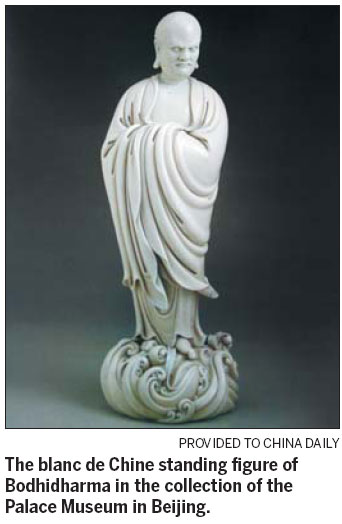A white porcelain statue that shapes and colors history
Updated: 2011-12-22 07:43
By Zhu Linyong (China Daily)
|
|||||||||
Editor's Note: Every week we look at a work of art or a cultural relic that puts the spotlight on China's heritage.
The best-selling biography of Apple co-founder Steve Jobs - the Chinese version became available only weeks ago - portrays a tech visionary deeply influenced by Zen Buddhism, evoking a surge of interest in the ancient philosophy among readers.
 |
Zen is a school of Mahayana Buddhism founded by the monk Bodhidharma from ancient India. The philosophy arrived in China in the 6th century, where it flourished and was called Chan Buddhism. It later bloomed in Japan and other parts of the world.
The legendary patriarch has been a favorite subject for generations of Chinese ink painters, sculptors and ceramicists.
A prime example of this is the blanc de Chine standing figure of Bodhidharma, now in the collection of the Palace Museum in Beijing. The 43-cm-high standing figure, covered in an ivory tone glaze, depicts the founder of the Zen sect riding waves, a scene portraying his tumultuous travel on the sea to China in 520 AD.
The figure portrays a contemplative monk from a foreign land. The face is finely modeled with curly beard, mustache and brows. His hands are hidden within the graceful folds of his loose robes, and the back is impressed with the gourd-shaped mark of its creator, He Chaozong.
The figure's serene expression and the fluid draping of his robes demonstrate the master craftsman's skill.
This Bodhidharma was made in Dehua, in today's southern Fujian province, in the 17th century, during the Ming Dynasty (13681644). Dehua is celebrated for its porcelain production. The Dehua kiln began production during the Song Dynasty (9601279). But most specimens were created during the Ming rule.
Dehua's kiln complexes are the source of a special type of porcelain known in the West as "blanc de Chine", Palace Museum researcher Geng Baocheng says.
These ceramic works have extremely fine-grained vitreous white bodies, embraced by a thick, satiny glaze with tones of milky white, warm ivory or a faint rose.
There are a wide variety of blanc de Chine vessels, including innumerous objects for the writing table. But the most glamorous are the figures representing Buddhist or Taoist deities, experts say.
These ceramic sculptures vary considerably in quality. But at their best they reveal a brilliance of modeling that raises them to the rank of true masterpieces, Geng says.

He Chaozong is widely considered the most influential of Ming ceramicists. He was entitled to sign the creations with his seals as a prominent blanc de Chine artist.
His wares include crisply modeled figures, cups, bowls and joss stick holders.
Most of He's porcelain sculptures are of religious figures, such as those of the historical Buddha Sakyamuni, the Bodhisattva Avalokitesvara (Guanyin in Chinese) Maitreya, Bodhidharma and Lu Dongbin, one of the eight Taoist immortals.
The images of Guanyin comprise the vast majority of He's repertory, while those of Bodhidharma are relatively few. That makes the standing Zen Buddhist statue an even rarer and more valuable piece.
China Daily











